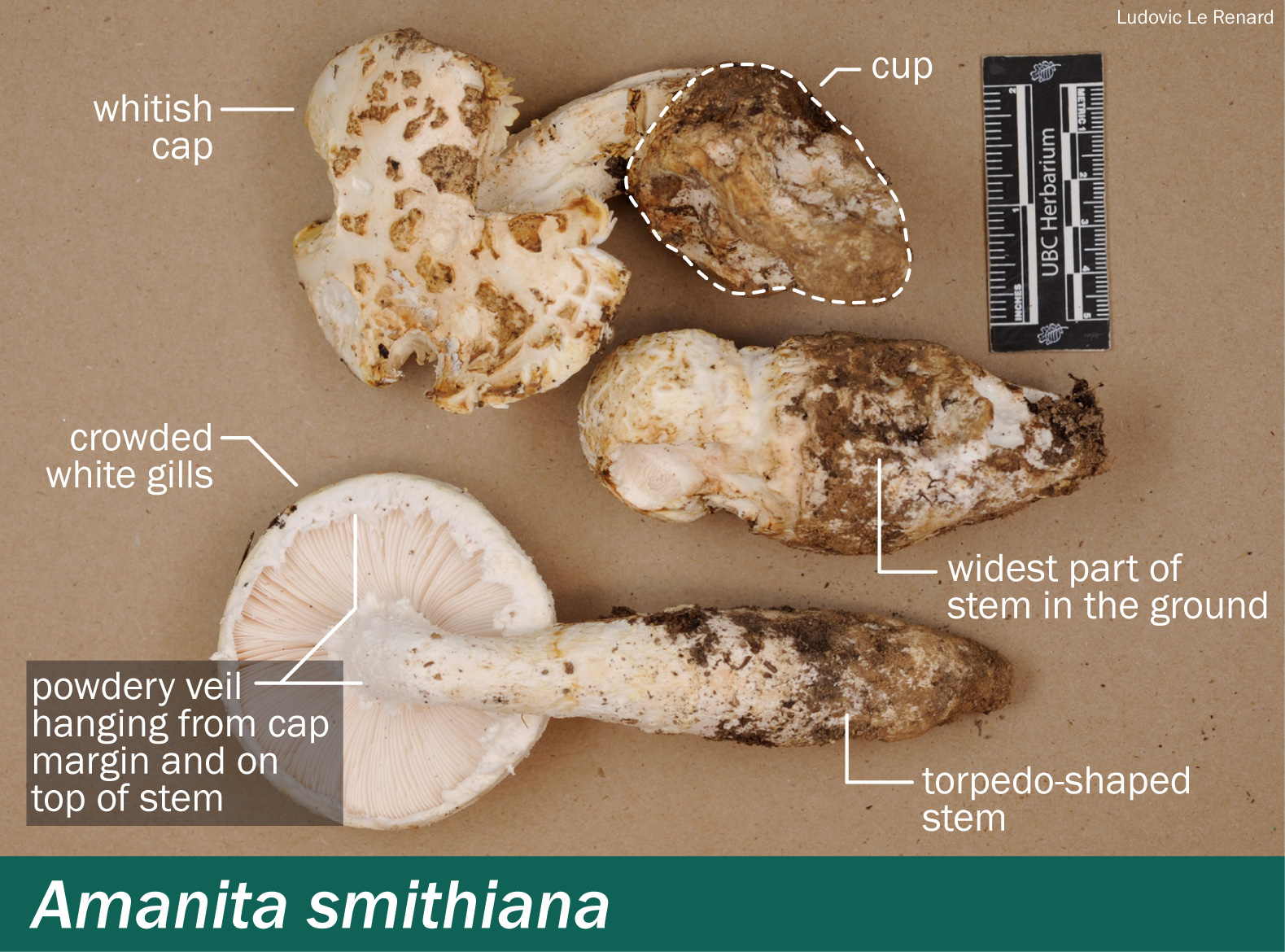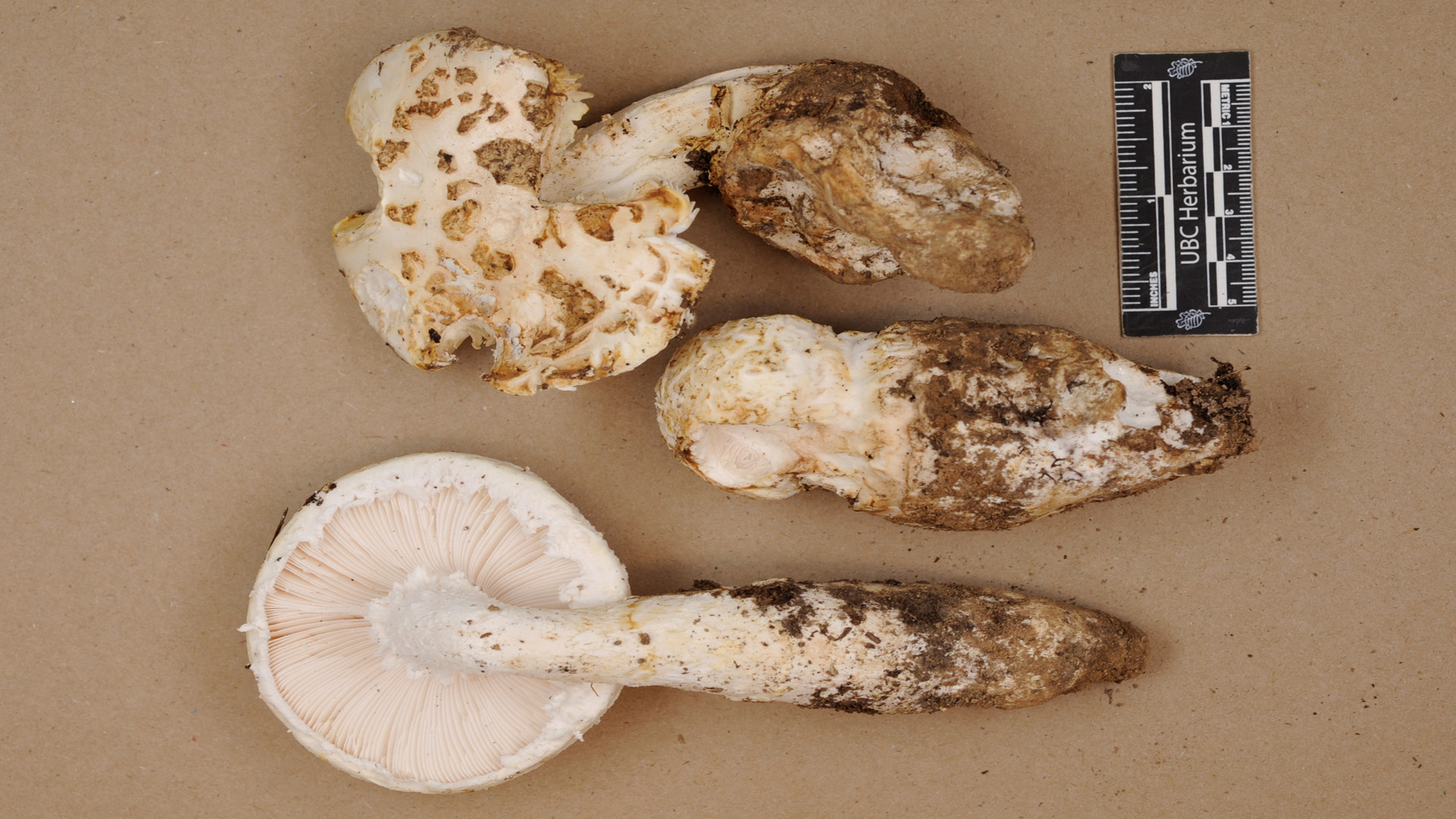Amanita smithiana — Smith's amanita
Poisonous
Warning: Do not mistake these poisonous, medium to large white mushrooms for edible matsutake (pine mushroom Tricholoma murrillianum or T. magnivelare). The two species can grow next to one another in the same habit.
Gills: White, free or narrowly attached at upper stem
Spore print: White
Medium-sized, white or whitish mushrooms. Edge of cap and stem are often shaggy with crumbly veil remnants. Dig out the stem base; the stem is usually widest at or below the level of the soil and it then tapers to a narrow base; torpedo-shaped, and sometimes extending into the soil like the base of a parsnip. Smith's amanitas commonly grow in the ground or rotten wood, in Douglas fir, hemlock and pine forests.
See distinctions under 'Similar Species'.
Odour: Mild at first, like green tomatoes but soon becomes unpleasant, described as decaying protein, slightly ammonium or bleach-like, or like ham gone bad3.
Taste: Tasting it is not recommended (see toxicity) but flavour has been recorded as mild to slightly sweet to unpleasant.
Cap: 5–15 cm wide, white to light tan, often with white to brownish warts. Initially convex and becoming flatter with maturity. Loose whitish tufts of the veil tissue that once covered the young gills may festoon the edge of the expanded cap like cottony icicles. The flesh is white, not changing colour when handled.
Gills: White, closely spaced and at first covered by a white veil. Gills are narrowly to broadly attached to the stem. The gill edges are often fringed with white crumbles of veil particles.
Stem: 6–20 x 2–3.5 cm, usually longer than the cap is wide, but much of the length is buried in the ground. The colour is white, bruising pinkish buff where handled. Sometimes the stem is covered with loose, white woolly tufts of tissue that may rub off on fingers. The stem widens near soil level, and then narrows as it continues down belowground so that the stem base is shaped like a torpedo or turnip. When picked, the narrowest part may break off in the soil making the base difficult to collect.
Ring or veil: Crumbly, white tufts of cottony tissue, usually forming ragged patches rather than a complete ring around the stem; also leaving remnants on fingers after handling. Missing in some older specimens.
Cup (volva): Closely pressed to stem, appearing as broken rings of white or light tan crumbly warts usually just above where the stem widens and above the soil line.
Spores: 8.5–12.0 x 5.5–8.0 µm, smooth, ellipsoid, amyloid (turning blue in Melzer's iodine solution).
Habitat: On ground. Associated trees3,5 include Douglas fir (Pseudotsuga menziesii), western hemlock (Tsuga heterophylla), bishop pine (Pinus muricata), and other pine species, and Sitka spruce (Picea sitchensis); ectomycorrhizal.
Geographical range1: Western North America inland to Idaho; Mexico to BC.
- Stem break test: Can you break or remove the stem by holding it firmly and rocking it from side to side? The stem of Smith’s amanita will break off if wiggled back and forth, sometimes coming cleanly off in one piece and leaving a round depression under the cap. Pine mushroom stems are solid and firmly attached to both the gills and the cap and you would have to mangle the mushroom to remove the stem.
- Stem squeeze test for Smith’s amanita6: lay the stem of the mushroom in the palm of your hand and then squeeze down on the side of the stem, reasonably hard, with your thumb. The Amanita smithiana is firm but will shatter if you push hard enough. The stem of the pine mushroom is denser and will not shatter (unless full of maggots and then you may not want to eat it anyway).
- Stem shape test. Dig out the belowground part of the stem. In Smith’s amanita, the stem is widest at or below the level of the soil and it then tapers to a narrow base; it is torpedo-shaped, or like a parsnip. Pine mushroom stems are usually widest aboveground near the ring and they do not extend deeply into the soil.
- Odour. Smith’s amanita has a mild or unpleasant odour. The odour of pine mushrooms is sweet/cinnamon-like with overtones of dirty gym socks.
- Overnight bend test. Stems of Smith’s amanita are geotropic and will bend to reorient gills if mushrooms are left in a pile overnight. Pine mushroom stems do not bend.
Toxins: Uncertain, likely include one or more amino sugars such as allenic norleucine10.
Symptoms: 20 minutes to a day after eating mushrooms, gastrointestinal symptoms, abdominal cramps, diarrhea and vomiting may appear; 2-6 days later, kidney failure may follow indicated by polyuria or anuria and high levels of blood urea nitrogen and serum creatine8,11.
Treatment: Contact your regional Poison Control Centre if you or someone you know is ill after eating any amanita mushrooms. Poison centres provide free, expert medical advice 24 hours a day, seven days a week. If possible, save the mushrooms or some of the leftover food containing the mushrooms to help confirm identification.
Poison Control:
British Columbia: 604-682-5050 or 1-800-567-8911.
United States (WA, OR, ID): 1-800-222-1222.
Smith's amanitas have caused serious poisonings in western North America including:
- In 2016 a man picked and ate a large quantity of what he thought were pine mushrooms collected on Vancouver Island, BC. After seven hours he developed vomiting and diarrhea and was admitted to hospital where he experienced kidney failure and required hemodialysis for several days.
- In 2011 an adult man collected Smith's amanitas on a Gulf Island near Vancouver, BC mistaking them for pine mushrooms, and included them in a mixed mushroom soup. He fell ill 4 hours after eating the soup and two days later, went to the hospital with difficulty urinating and other symptoms of kidney failure. The mushroom was identified by thin layer chromatography and by microscopic examination of spores and tissue remaining in a sample of the soup. The patient recovered after 9 days of treatment including hemodialysis9.
- A couple collected mushrooms in the Mount Rainier area in Washington. Each person ate ~3 mushrooms cooked with beef. Some ~ 6-12 hours later, they fell ill with nausea and vomiting. In 2 days, the husband and in 3-4 days the wife experienced difficulty urinating that signalled kidney failure. Smith's amanita was believed responsible based on the couple's descriptions of the mushrooms and on timing and symptoms of the illness. After hospitalization and 3-4 weeks of hemodialysis, both individuals recovered8.


